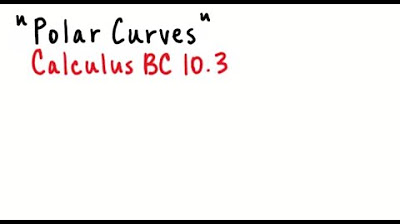Monday Night Calculus: Polar equations
TLDRIn this engaging and informative session, Curtis Brown is joined by Steve Kakaska and Tom Dick to explore the fascinating world of polar equations in calculus. The trio delves into the background of polar coordinates, parametric equations, and the intricacies of finding slopes along polar curves. They tackle complex problems, including identifying horizontal and vertical tangent lines and calculating areas enclosed by polar regions. The session also highlights the use of technology in visualizing and solving these problems, emphasizing the powerful combination of mathematical concepts and technological tools.
Takeaways
- 📚 The session focused on exploring polar equations and their applications in calculus, specifically in finding slopes of tangent lines, areas, and lengths of polar curves.
- 🌀 Polar curves, described by r = f(theta), can be analyzed for their geometric and tangent properties using calculus and trigonometry.
- 📈 The slope of a polar curve at a specific point can be found using the derivative dy/dtheta divided by dx/dtheta, derived from the parametric equations x = r*cos(theta) and y = r*sin(theta).
- 🤔 Horizontal and vertical tangent lines on polar curves can be identified by setting dy/dtheta and dx/dtheta to zero, respectively, and solving for theta.
- 📊 The area enclosed by a polar curve can be calculated using integral calculus, approximating the region by sectors and summing their areas.
- 🏢 A graphing calculator is a powerful tool for visualizing polar equations and their properties, such as intersections, symmetry, and the behavior of r values across different theta intervals.
- 🔍 The session highlighted the importance of understanding the domain and range of polar functions when plotting and analyzing them.
- 📝 When dealing with zero over zero indeterminate forms in limits, techniques like L'Hopital's rule or direct substitution can be used to find the limit's value.
- 🔧 The use of trigonometric identities, such as half-angle formulas, can simplify the integration process and help in evaluating definite integrals for areas under polar curves.
- 🛠️ The session provided practical tips for tackling polar equation problems, including the use of symmetry, factoring, and the application of calculus concepts like limits and derivatives.
- 🎓 The discussion emphasized the educational value of engaging with complex problems, even those that might be calculator-active, to deepen understanding and develop problem-solving skills.
Q & A
What topic is the video primarily focused on?
-The video is primarily focused on polar equations and their applications in calculus, including graphing and finding slopes of tangent lines on polar curves.
How does the presenter introduce the concept of polar coordinates in the video?
-The presenter introduces polar coordinates by discussing the equation r = f(theta) and the parametric equations that describe a polar curve, emphasizing the role of theta as the parameter.
What is the significance of the polar curve's slope at a specific point?
-The slope of a polar curve at a specific point is significant because it helps in understanding the tangent line behavior, whether it's horizontal, vertical, or somewhere in between, which is crucial for analyzing the curve's properties and graphing it accurately.
How does the video address the issue of finding horizontal and vertical tangent lines on a polar curve?
-The video addresses this by discussing the conditions under which a horizontal or vertical tangent line occurs. For a horizontal tangent line, the numerator of the slope equation must be zero (provided the denominator is non-zero), and for a vertical tangent line, the denominator must be zero (provided the numerator is non-zero).
What role does technology play in the discussion of polar equations in the video?
-Technology is used to visualize and graph polar equations, making it easier to understand their properties and behavior. It's also used to calculate and approximate values that are crucial for solving problems related to polar coordinates.
How does the video handle the concept of a tangent line's slope at the pole in polar coordinates?
-The video explains that at the pole, where r equals zero, the slope of the tangent line can be found by taking limits and using trigonometric identities, such as the tangent of theta when the rd theta term is non-zero.
What is the significance of the cardioid curve discussed in the video?
-The cardioid curve is used as an example to illustrate how to find the slope of a tangent line at a specific point (theta equals pi over six) and to identify points where the tangent line is horizontal or vertical, enhancing the understanding of polar curve properties.
How does the video address the issue of a zero over zero indeterminate form in the context of polar equations?
-The video suggests using L'Hôpital's rule to handle the zero over zero indeterminate form, by taking the derivative of the numerator and the denominator separately and then evaluating the limit to find the slope of the tangent line.
What is the main application of polar coordinates discussed in the video?
-The main application discussed is finding the area of a region bounded by a polar curve and the polar axis, using the integral of half the square of the radial function over the interval of interest.
What trigonometric identity is used in the video to simplify the integration of the area of a polar region?
-The video uses the half-angle identity to simplify the integration process when calculating the area of a polar region, particularly when dealing with cosine squared terms.
Outlines
📚 Introduction to Polar Equations
The video begins with an introduction to polar equations in the context of calculus. The speakers, Curtis, Steve, and Tom, express excitement about exploring the topic together. They plan to discuss the relationship between polar equations and calculus, the visualization of beautiful graphs associated with polar coordinates, and the technical aspects of plotting these curves. The conversation sets the stage for a deep dive into the mathematical concepts and their applications.
📐 Polar Coordinates and Parametric Equations
This section delves into the specifics of polar coordinates and parametric equations. The discussion revolves around the equation r = f(theta) and how to plot polar curves using both manual methods and technology. The concept of converting between polar and rectangular coordinates is introduced, along with the idea of finding the slope of a polar curve at a specific point. The segment also touches on the challenge of identifying points where the slope is undefined, leading to an open question for the audience to ponder.
📊 Analyzing Polar Curves and Tangent Lines
The focus shifts to analyzing polar curves, specifically the cardioid described by r = 1 - cos(theta). The conversation explores the slope of the tangent line to the graph and how to find points where the tangent line is horizontal or vertical. The use of trigonometric identities to simplify expressions and the application of calculus concepts to determine the slope are discussed. The segment also addresses the intriguing case of a zero over zero slope and how to resolve it using limits.
🌀 Exploring Areas of Polar Regions
This part of the discussion introduces the concept of calculating the area enclosed by polar regions. Using the polar equation r = f(theta), the speakers explain how to approximate areas using Riemann sums and the fundamental theorem of calculus. The practical application of this method is demonstrated by calculating the area enclosed by a specific polar curve. The segment emphasizes the power of calculus in solving real-world problems and the beauty of mathematical concepts.
🧩 Solving Problems with Polar Coordinates
The conversation continues with a series of problems that illustrate the application of polar coordinates in solving various mathematical challenges. These include finding the area of a region bounded by two polar curves, dealing with the intersection of curves, and calculating the length of a curve. The segment highlights the use of trigonometric identities, symmetry, and calculus in tackling these problems. The speakers also discuss the potential for these types of questions to appear on exams and the importance of understanding the underlying concepts.
🔍 Investigating the Spiraling Curve
The speakers turn their attention to a specific polar curve defined by r = 2*theta/π and explore its properties. They discuss the shape of the curve, how to find the equation of a tangent line at a given point, and how to determine the first value of theta where the tangent line is vertical. The segment also covers the calculation of the area enclosed by the curve and a line segment, showcasing the integration of various mathematical techniques.
🐰 Rabbit Ears Graph and Polar Plotting
In this segment, the speakers examine a polar equation involving sine and cosine functions and discuss its graph, known as the 'rabbit ears.' They explore the use of graphing calculators to visualize polar curves and the impact of technology on mathematical education. The conversation includes practical tips for using graphing calculators to plot and analyze polar graphs, the importance of understanding the domain of a function, and the potential challenges in graphing certain types of curves.
🌐 Interactive Exploration of Polar Graphs
The final part of the discussion involves an interactive exploration of polar graphs using graphing calculators. The speakers demonstrate how to use the trace and animated path plot features to visualize and understand the behavior of polar curves. They encourage viewers to experiment with different polar equations and appreciate the power of technology in mathematical exploration. The segment concludes with a reminder to share these learnings with students and a look forward to future discussions.
Mindmap
Keywords
💡polar equations
💡parametric equations
💡slope of a curve
💡horizontal and vertical tangent lines
💡area of polar regions
💡tangent lines to polar curves
💡graphing calculator
💡trigonometric identities
💡l'Hopital's rule
💡Riemann sum
Highlights
Introduction to polar equations and their relation to calculus
Discussion on converting polar coordinates to rectangular coordinates
Explanation of finding the slope of a polar curve at a specific point
Use of parametric equations to describe polar curves
Technological assistance in visualizing polar graphs
Method for finding horizontal and vertical tangent lines on polar curves
Illustration of the cardioid curve and its properties
Application of calculus concepts to find the area of polar regions
Integration of trigonometric identities in solving polar equations
Demonstration of the polar curve r = 1 - cos(theta) and its tangent lines
Exploration of the impact of theta values on the definition of r
Use of limits to address undefined expressions in polar coordinates
Calculation of the area enclosed by multiple polar curves
Integration of half-angle identities for simplifying polar integrals
Discussion on the potential exam implications of certain polar problems
Illustration and analysis of the spiral curve r = 2*theta/pi
Method for finding the length of a polar curve
Challenge of integrating complicated trigonometric expressions
Conclusion and summary of the key points from the discussion on polar equations
Transcripts
5.0 / 5 (0 votes)
Thanks for rating:





